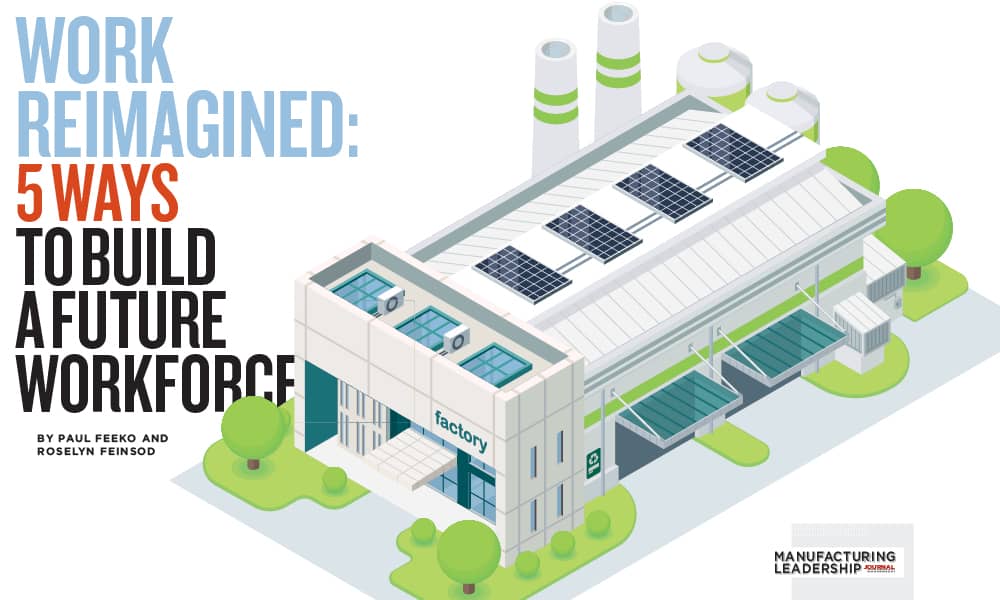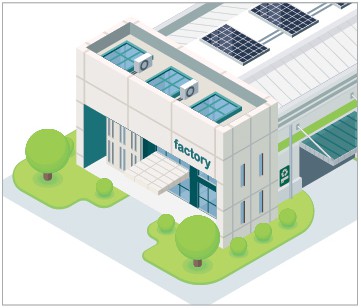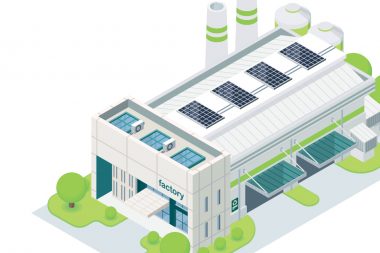Work Reimagined: 5 Ways to Build a Future Workforce

Manufacturers willing to change how they approach workforce development have an opportunity to stand apart from the competition.

For manufacturing companies, the challenges and uncertainty posed by the COVID-19 pandemic have been layered on top of persistent workforce trends that will remain unresolved even after social distancing fades from memory, and that can undermine their ability to innovate and thrive into the future.
Consider the aerospace and defense (A&D) sector, for example. While the commercial aerospace market has taken a hit amid the pandemic’s economic fallout, defense spending remains robust. A&D still has plenty of growth potential with the evolving drone market, which offers wide commercial applications. Plans are also on the table for air taxis and hydrogen-powered passenger aircraft, not to mention the nascent global space economy.
But seizing these innovative opportunities requires tech-savvy workers who are being increasingly drawn to other sectors with greater reputations for innovation, including technology, health care, and even gaming. In its 2020 World’s Most Attractive Employers report,¹ Universum found that A&D ranked below computer software and technology as a preferred industry to work in among new IT and engineering graduates. No A&D employers ranked among the report’s top 50 most attractive companies to work for.
Recruiting top talent in this and other advanced manufacturing sectors is only going to become more critical in the future. To remain competitive, industry leaders must continually develop their companies’ digital acumen and evaluate new technologies as they come into play. The ability to attract, develop, engage, retain, and inspire both the current workforce and the next generation of employees is essential. Learning programs and systems also need to be in place for upskilling and reskilling employees to help those companies succeed.
In addition, these same leaders must change their own ways, embracing new behaviors and value systems and getting comfortable with shifting corporate structures and collaborative cultures. In short, the manufacturing industry must revisit its overall personnel strategy to attract the best and brightest thinking among demographics whose career mindsets and preferences differ from previous generations.
Transformation is not a singular proposition in today’s environment, if it ever was.² For organizations to truly reimagine their working worlds and reshape their futures, transformation programs need to live, breathe, and continuously evolve. This is particularly true of an organization’s workforce. If, as is expected, the global economy begins recovering in 2021, even greater competition in labor markets will be a given.
With that prospect ahead, there are five ways that manufacturers can help make their workforce approach stand apart from the rest.
1. Define and promote a purpose and culture
Younger employees appreciate a strongly felt and inspiring purpose or mission, beyond a profit motive. The pandemic has reset and raised the bar. Fifty one percent of manufacturing employees in 2021 EY Work Reimagined Employee survey3 felt that culture actually improved during the pandemic with a focus on people first and intense communications. They want to play a role in realizing a future vision. Industrial companies need to play the culture card by creating a more purposeful, flexible, and agile work environment to attract millennials. Many technology companies have announced work from anywhere opportunities and are actively recruiting talent from manufacturers that historically had been safe, if not head-to-head, with one of the tech hubs. That a lot of emerging technologies are targeting the industrial sector is also building appeal, providing opportunities for millennials to work with cutting-edge tech and apply it in unprecedented ways. This isn’t just about attracting talent. It’s also about keeping it.

“A majority of workers want to maintain a similar level of flexibility in their work when the pandemic is over.”
The convergence of new technologies can fundamentally shift the manufacturing enterprise, supporting the movement to M4.0. Manufacturers should be embedding artificial intelligence, blockchain, and robotics in their operations today and finding talent anywhere they can that can help them do it effectively. A new global workforce with the ability to augment these technologies is beginning to emerge. Manufacturing companies should be more direct in highlighting these opportunities to potential recruits and delivering on them to their current workers.
Yet, in another EY survey,4 more than one-third of employees (35%) reported a disconnect between their organization’s stated purpose and its day-to-day actions. Manufacturers need to take steps to bridge this gap by defining the day-to-day attributes that define culture in both the work the company does and the behaviors of all colleagues.
If the company stepped up to play a role in the fight against COVID-19, be proud of that effort and make sure employees feel that pride as well. If the company is helping to advance autonomous technology or developing new ways to decarbonize the business, or simply coming up with new processes that are more efficient and more productive, make sure it matters to the team as much as it does to the company’s customers and key stakeholders. If the company is supporting employee wellbeing and work-life balance, make sure that leaders are promoting flexibility for the jobs and roles where it is available. When people have a purpose and feel connected to the culture, they’ll be much more likely to take ownership of it.
For A&D, there is a strong focus on culture and, within that, the purpose behind the sector’s nonfinancial objectives. In commercial aerospace, it’s about passenger safety, not profit. Teams are at their best when they are fundamentally thinking about how to get people where they need to be safely. It’s the same concept with the defense industry. The opportunity to support national security and provide the military with the best technology and tools it needs to do fulfill its mission and applying the latest tech to help it do so, gives deep meaning to a team’s effort and sense of purpose.
Employees want to be part of a team, and they want that team to be engaged in doing meaningful work. Finding the right balance in a world where remote working is becoming more common, is important. In the 2021 EY Work Reimagined Employee survey, 54% of US manufacturing respondents indicated they value the ability to meet and interact with colleagues in their workplace and 62% reported being concerned about the ability to meet with remote team members. At the same time, 40%+ consider themselves to be remote ready, and value the flexibility of the option to work virtually in many jobs and roles.

“The manufacturing industry must revisit its overall personnel strategy to attract the best and brightest thinking.”
2. Recognize that workforce expectations are changing
In spite of the challenges posed by the pandemic, employees remain positive about their work. In the 2021 EY Work Reimagined Employee survey, 62% of US manufacturing respondents said it’s “very likely” they will stay in their current job for the next 12 months. A majority of these workers, however, want to maintain a similar level of flexibility in their work when the pandemic is over, including the 69% who indicated they would like to choose when they start and finish their work each day.
If preferences for when and where they work aren’t met, 35% of respondents said it’s “likely” they would quit, and 19% said it’s “very likely” they would leave their job.
The key takeaway is that all employers, including those in the manufacturing sector, need to rethink how they approach the future of workforce development and working cultures. The pandemic has proved across most industries that a high level of productivity can be achieved outside of the traditional construct of employees working eight hours a day, five days a week, in the office or on the plant floor.
It’s not a millennial issue, or an us-versus-them conflict between labor and management. Everyone needs to work together to build a model that maximizes potential and gives a company the best chance to succeed. In some cases, the best structure is to have people in a certain spot at a certain time each day. Certainly, manufacturing is one of those sectors that can’t be done entirely by remote work. But those companies that are willing to have an open dialogue with their teams and discuss the best way to move forward will be the businesses that put themselves in a better position to attract, and retain, the best talent.
3. Be more diverse and inclusive
Considering the continuing disruption and challenges on the horizon, the most successful companies need to recruit for diversity of thought. Manufacturing companies owe it to themselves to look at candidates from outside of their traditional recruitment venues. It’s not always easy. In the A&D sector, government contractors are typically constrained by citizenship and security clearance barriers. Other segments of manufacturing have their own barriers that come into play. On the one hand, they want to pull from a wider pool of talent. But companies often have specific needs or skills, so it becomes easier to stick to what they know.
As with many aspects of both life and business, you get out of a particular effort what you put into it. If companies really want to find the best people to hire, they are most likely going to have to work at it. That means casting a broad net and proactively finding ways to develop talent where they haven’t found it before. One way is to hire for skills instead of specific credentials and be willing to mold talent. Companies need to examine their internal culture and practices to ensure they can champion and coach high-caliber individuals to drive the next generation of leadership. They may find people who always had the skills to be a force in their industry but never thought it was a viable option for their career path.
4. Thoughtfully consider politically charged topics
Companies in every sector have begun to very visibly take stands on broader public issues where in the past they may have opted to remain more neutral. However, employees in the newer generation of workers expect their employers to be more purpose driven and vocal, especially against perceived injustices and inequities.
Companies need to determine where they stand on these issues publicly and be willing to back their positions up with action. That can also tie in to how they present their company’s purpose to recruits and the types of recruits they appeal to. For instance, during US protests about policing practices, one large aerospace company announced that it was issuing millions in grants for groups that serve minority and underserved students pursuing science, technology, engineering, and math (STEM) education.
Many manufacturing companies are understandably focused on the short-term day-to-day challenges of keeping their employees safe amid the pandemic, balanced against the need to continue being productive. But they can’t let the troubles of today obscure the potential of the future: broader workforce and talent initiatives will be required to strengthen the business over the long term. They need to take steps to embed a clear and meaningful purpose throughout the organization and to create an environment in which it is defined and lived, authentically, at all levels.

“The key takeaway is that all employers, including those in the manufacturing sector, need to rethink how they approach the future of workforce development and working cultures.”
5. Redefine the role of HR
The future of work means HR has to evolve to drive the people experience, serve as an innovation hub, and deliver value outside its traditional role. A recent episode of the EY Future of HR podcast series5, for example, addressed the concept of a “people value chain” as a way to help redefine the HR role for the years ahead.
In the past, 80% of HR’s time and budget was dedicated to traditional vertical services that were largely administrative and operational. The remaining 20% of HR’s time and budget was then focused on more horizontal people services which, ultimately, are most important to developing employee experience and longer-term value to the company. The people value chain concept shifts the more traditional HR activities, such as administrative and procedural services, to a digital people team and virtual global business services, enabling the company’s people consultants to transition into more strategic work that provides long-term value.
To deliver experience at scale, the people function of the future must work horizontally across the enterprise. The people consultant role is fueled by key collaborations with cross-functional teams, executive leadership, virtual business services teams, and the gig workforce, using a mix of human and digital interactions, and allowing high-value people consultants to expand their reach within and beyond the traditional HR function in a number of ways.
-
- Cross-functional teams: functional leaders serve both as beneficiaries of HR services, and as cross-functional partners with input and shared accountability for people contributions and experiences.
- Architect people solutions for business opportunities: serve as the primary people advisor to the executive leadership team and bring the right combination of people capabilities to the boldest ambitions and most difficult business challenges.
- Foster program and service execution through virtual Global Business Services (GBS): prepare virtual GBS teams to execute programs and deliver services at scale; understand feedback and partner to innovate and drive continuous improvement.
- Human and digital and the gig economy: digitize HR work, augment people contributions with intelligent automation and enable confident business decisions through rich people insights. Enable gig people consultants to accelerate through the company learning curve and add value to in-flight initiatives.
In this new model, people consultants will be able to focus on the high value-add areas, where typically only 20% of time and budget is currently focused. This new model allows the people consultants to dedicate most of their time on these horizontal people services that drive long-term value.
Reset for the Future
Culture and HR management are often overlooked in the world of manufacturing, where the primary focus has often been on the machines, the products, and the processes that keep the company in business. With the pandemic, however, HR has been at the center of a reset of enterprise focus, from rethinking the use of office space, to redefining health and safety, and the introduction of new workplace technologies for enhanced collaboration and communication.
Today’s successful manufacturers are now coming to understand that they need to devote just as much time to talent acquisition, retention, and experience as they do to every other function in their organization if they want to successfully reimagine the way work is performed and managed in the future to maintain competitiveness.
The views reflected in this article are those of the authors and do not necessarily reflect the views of Ernst & Young LLP or other members of the global EY organization.
Footnotes
1 https://universumglobal.com/blog/the-worlds-most-attarctive-employer-2020/
2 https://www.ey.com/en_us/workforce/how-to-keep-your-people-continuously-ready-for-what-is-next
3 https://www.ey.com/en_gl/news/2021/05/more-than-half-of-employees-globally-would-quit-their-jobs-if-not-provided-post-pandemic-flexibility-ey-survey-finds
4 https://www.ey.com/en_us/purpose/is-your-purpose-lectured-or-lived
5 https://www.ey.com/en_gl/podcasts/2021/03/episode-2-how-people-consultants-will-define-the-future-of-hr